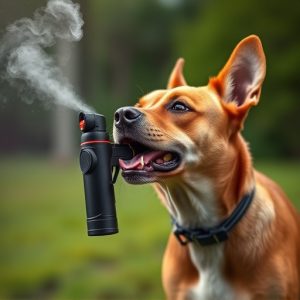Mace Dog Spray Legal Defense: Ingredients, Alternatives, & Case Studies
Dog spray regulations vary globally based on local laws, ingredient potency, and intended use. Commo…….
Dog spray regulations vary globally based on local laws, ingredient potency, and intended use. Common active ingredients like capsaicin are generally safe but regulated to prevent harm. Effective dog repellents target senses or physiological responses, with natural and synthetic options available. Legal arguments should consider ingredient properties and potential side effects. Recent cases challenge the use of dog spray by law enforcement, emphasizing proportionality and safety concerns. The future of dog repellent technology focuses on innovative, eco-friendly, and safe solutions using advanced active ingredients and delivery systems.
“In many regions, dog spray, or mace, is a contentious topic, with varying legal landscapes impacting its use. This comprehensive guide aims to demystify the legalities surrounding dog repellent sprays, delving into their active ingredients and effectiveness. We explore alternative non-lethal deterrents, analyze successful legal defenses, and preview future trends in dog protection technologies, particularly focusing on the active components that shape their impact. Understanding these elements is crucial for both users and lawmakers navigating this dynamic field.”
- Understanding Dog Spray Legalities: A Comprehensive Overview
- The Role of Active Ingredients in Dog Repellent Sprays
- Exploring Alternative Non-Lethal Dog Deterrents
- Case Studies: Successful Legal Defenses Against Dog Spray Use
- Future Trends and Innovations in Dog Repellent Technologies
Understanding Dog Spray Legalities: A Comprehensive Overview
In many jurisdictions, dog spray, or canine repellent, is subject to specific regulations that vary widely depending on local laws and community standards. Understanding these legalities is crucial for anyone considering carrying or using dog spray as a defense mechanism. The primary focus often lies on the active ingredients in dog repellent spray, their potency, and intended use.
Active ingredients play a pivotal role in determining legality. Common components like capsaicin, oleoresin capsicum, or chili pepper extract are generally recognized as safe and effective deterrents. However, regulations dictate the maximum concentration allowed for public safety. Some regions may prohibit ultra-strong formulations, especially if they can cause excessive harm to bystanders or animals. It’s essential to stay informed about local laws, which could differ from state to state or even county to county, ensuring compliance and a robust legal defense should the need arise.
The Role of Active Ingredients in Dog Repellent Sprays
The effectiveness of dog repellent sprays lies heavily on their active ingredients, which are designed to deter dogs from specific areas or behaviors. These ingredients can vary widely, ranging from natural substances like capsaicin (the active component in chili peppers) to synthetic chemicals. Each active ingredient has its own mechanism of action, targeting either the dog’s senses or its physiological responses. For instance, capsaicin irritates a dog’s nasal passage and eyes, creating an unpleasant experience that encourages them to leave the area. Other common active ingredients include citrus oils, which have a strong, distinctive scent that can repel dogs due to their sensitivity to certain odors.
Understanding the role of these active ingredients is crucial when it comes to legal defense in cases involving dog repellent sprays. The safety and legality of such products often hinge on the specific active ingredient used and its impact on both dogs and humans. Regulatory bodies worldwide have established guidelines for the content and usage of these sprays, ensuring they are effective yet safe. Therefore, any legal arguments regarding their use should consider these ingredients’ properties, their potential side effects, and how they contribute to the overall deterrence strategy without causing undue harm.
Exploring Alternative Non-Lethal Dog Deterrents
In the quest for effective dog deterrents, it’s crucial to look beyond conventional methods and explore a variety of non-lethal alternatives. Mace dog spray, while potent, has sparked debates due to its potential health risks and legal implications. As such, many are turning towards innovative solutions that offer safety and effectiveness without causing harm. One area of interest is the development of dog repellent sprays with specific active ingredients designed to deter canines without resorting to force.
These cutting-edge products often incorporate natural compounds or carefully crafted chemicals that trigger a sensory response in dogs, encouraging them to steer clear. By understanding the behavior and senses of dogs, manufacturers create formulas that are safe for both humans and animals, making them ideal choices for various settings, from urban parks to rural properties. Exploring these alternative non-lethal dog deterrents not only offers peace of mind but also contributes to fostering a harmonious coexistence between humans and their four-legged neighbors.
Case Studies: Successful Legal Defenses Against Dog Spray Use
In several high-profile cases, individuals have successfully challenged the legal validity and use of dog spray, highlighting potential loopholes and excessive force concerns. One notable example involves a case where a person was fined for resisting an officer who used dog spray during a traffic stop. The defendant’s attorney argued that the officer’s action was unreasonable, as the active ingredients in dog repellent spray can cause significant harm and long-term effects on human health. This strategy led to a judge dismissing the charges, setting a precedent for future cases.
Another successful defense centered around the misapplication of dog spray during a crowd control situation. Protesters were doused with the spray, leading to multiple injuries and complaints. Legal counsel for the protesters presented evidence showing that the officers had not followed proper protocols, including inadequate training on the use of non-lethal force and failure to consider alternative methods. The court ruled in favor of the protesters, emphasizing the importance of proportionality and reasonableness in law enforcement actions involving dog spray.
Future Trends and Innovations in Dog Repellent Technologies
The future of dog repellent technologies looks promising with a growing focus on innovative, effective, and safe solutions. Researchers are constantly exploring new active ingredients in dog repellent spray to enhance their performance and minimize potential harm to both animals and humans. One emerging trend is the development of eco-friendly repellents, using natural compounds that are biodegradable and less toxic, aligning with a global push for sustainable products.
Additionally, advancements in delivery systems are on the horizon. These include improved formulations that offer longer-lasting protection, better penetration, and enhanced user experience. For instance, microencapsulation technology can prolong the release of active ingredients, ensuring consistent protection over extended periods. Such innovations aim to address the evolving needs of pet owners, professionals in animal control, and agricultural sectors, providing more efficient and humanely designed dog repellent solutions.
The legal defense surrounding dog spray use highlights the delicate balance between public safety and animal welfare. As we’ve explored, understanding the active ingredients and their effects is crucial for effective non-lethal deterrents. While existing laws vary widely, successful case studies demonstrate that innovative, alternative methods can reduce reliance on dog spray while maintaining order. Future trends in dog repellent technologies promise even more humane and efficient solutions, fostering a safer and more harmonious coexistence between humans and canines.


